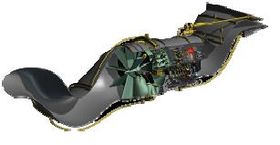Variable cycle engine
This article needs additional citations for verification. (September 2009) |

A variable cycle engine (VCE), also referred to as adaptive cycle engine (ACE), is an aircraft jet engine that is designed to operate efficiently under mixed flight conditions, such as subsonic, transonic and supersonic.
The next generation of supersonic transport (SST) may require some form of VCE. To reduce aircraft drag at supercruise, SST engines require a high specific thrust (net thrust/airflow) to minimize the powerplant's cross-sectional area. This implies a high jet velocity supersonic cruise and at take-off, which makes the aircraft noisy.
Specific thrust
A high specific thrust engine has a high jet velocity by definition, as implied by the approximate equation for net thrust:[1]
where:
- intake mass flow rate
- fully expanded jet velocity (in the exhaust plume)
- aircraft flight velocity
Rearranging the equation, specific thrust is given by:
So for zero flight velocity, specific thrust is directly proportional to jet velocity.
The Rolls-Royce/Snecma Olympus 593 in Concorde had a high specific thrust in supersonic cruise and at dry take-off. This made the engines noisy. The problem was compounded by the need for a modest amount of afterburning (reheat) at take-off (and transonic acceleration).
Concepts
One SST VCE concept is the tandem fan engine. The engine has two fans, both mounted on the low-pressure shaft, separated by a significant axial gap. In normal flight, all the entering air passes through the entire engine (series mode). The flow leaving the front fan passes directly into the second fan, so that the engine behaves much like a turbofan.
However, for take-off, climb-out, approach, and final-descent, air passing the front fan is ducted through an auxiliary nozzle on the underside of the nacelle, skipping the rest of the engine. Auxiliary intakes on each side of the powerplant open to allow air to avoid the front fan, reach the rear fan directly, and progress through the rest of the engine (parallel mode). Parallel mode substantially increases the total airflow of the engine, lowering jet velocity and noise. In the 1970s, Boeing modified a Pratt & Whitney JT8D to use a tandem fan configuration and successfully demonstrated the switch from series to parallel operation (and vice versa) with the engine running, albeit at partial power.
In the mid-tandem fan concept, a high specific flow single stage fan is located between the high pressure (HP) and low pressure (LP) compressors of a turbojet core. Only bypass air is allowed to pass through the fan. The LP compressor exit flow passes through special passages within the fan disc, directly underneath the fan rotor blades. Some of the bypass air enters the engine via an auxiliary intake. During take-off and approach the engine behaves much like a conventional turbofan, with an acceptable jet noise level (i.e., low specific thrust). However, for supersonic cruise, the fan variable inlet guide vanes and auxiliary intake close-off to minimize bypass flow and increase specific thrust. In this mode the engine acts more like a 'leaky' turbojet (e.g. the F404).
In the mixed-flow turbofan with ejector concept, a low bypass ratio engine is mounted in front of a long tube, called an ejector. This silencer device is deployed during take-off and approach. Turbofan exhaust gases induce additional air into the ejector via an auxiliary air intake, thereby reducing the specific thrust/mean jet velocity of the final exhaust. The mixed-flow design is not particularly efficient at low speed, but is considerably simpler.
The three-stream architecture adds a third, directable air stream. This stream bypasses the core ratio when fuel efficiency is required or through the core for greater power. Under the Versatile Affordable Advanced Turbine Engines (VAATE) program, the U.S Air Force and industry partners developed this concept under the Adaptive Versatile Engine Technology (ADVENT) and the follow-on Adaptive Engine Technology Demonstrator (AETD) and Adaptive Engine Transition Program (AETP) programs.[2] Examples include the General Electric XA100 and the Pratt & Whitney XA101, as well as the propulsion system for the Next Generation Air Dominance (NGAD) fighter.[3]
General Electric developed a variable cycle engine, known as the GE37 or General Electric YF120, for the YF-22/YF-23 fighter aircraft competition, in the late 1980s. GE used a double bypass/hybrid fan arrangement, but never disclosed how they exploited the concept. The Air Force instead selected the conventional Pratt & Whitney F119 for what became the Lockheed Martin F-22 Raptor.
See also
References
- ^ "Thrust equation". Archived from the original on 23 August 2006. Retrieved 20 March 2011.
- ^ Thomson, Daniel E. (14 April 2010). Versatile Affordable Advanced Turbine Engines Provide Game Changing Capability with Superior Fuel Efficiency (PDF). 11th Annual Science & Engineering Technology Conference/DoD Tech Expo. Charleston, South Carolina.
- ^ Mathews, Jim (26 June 2017). "Engines of Innovation". Air Force Magazine. Retrieved 11 January 2020.





